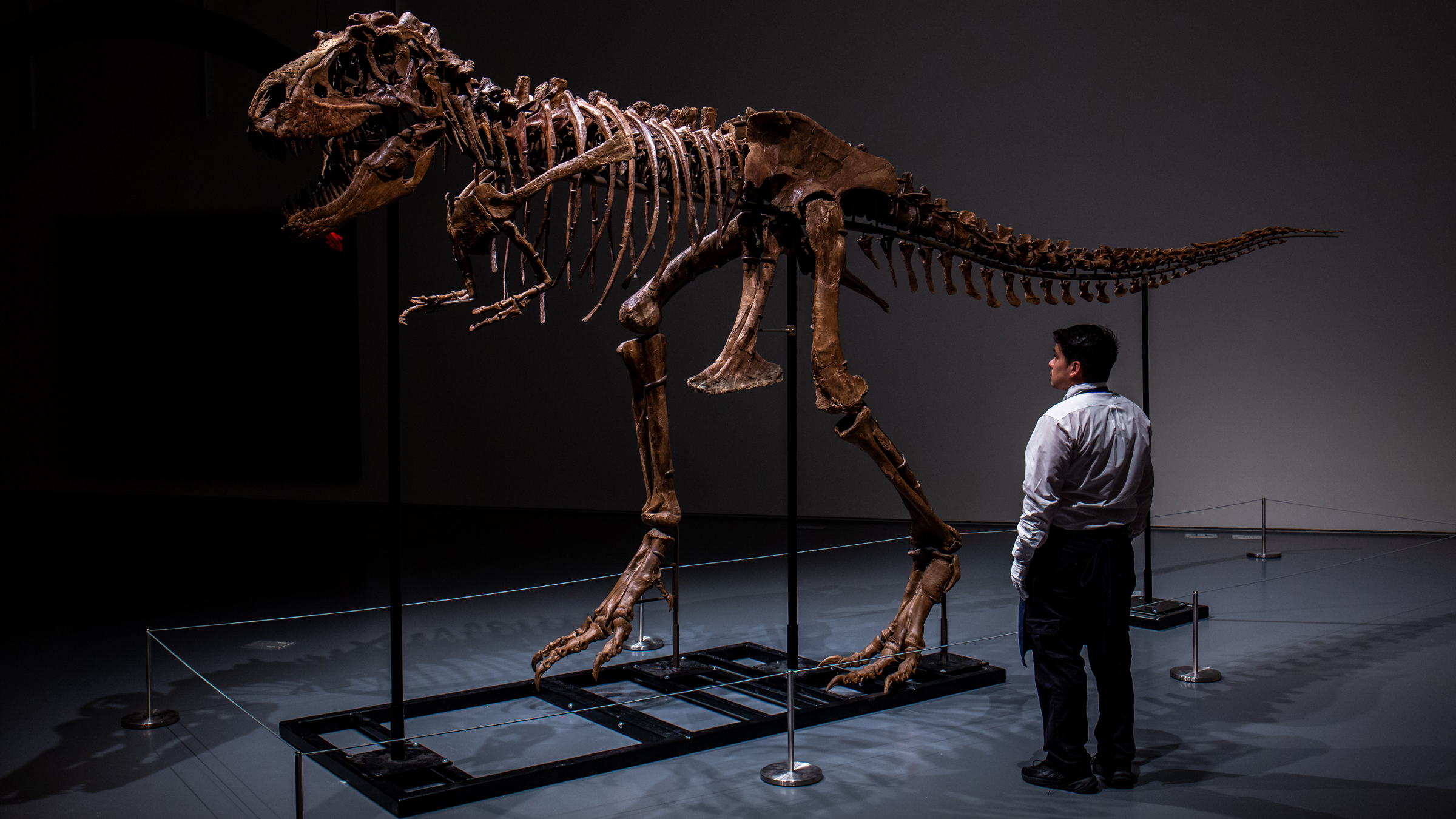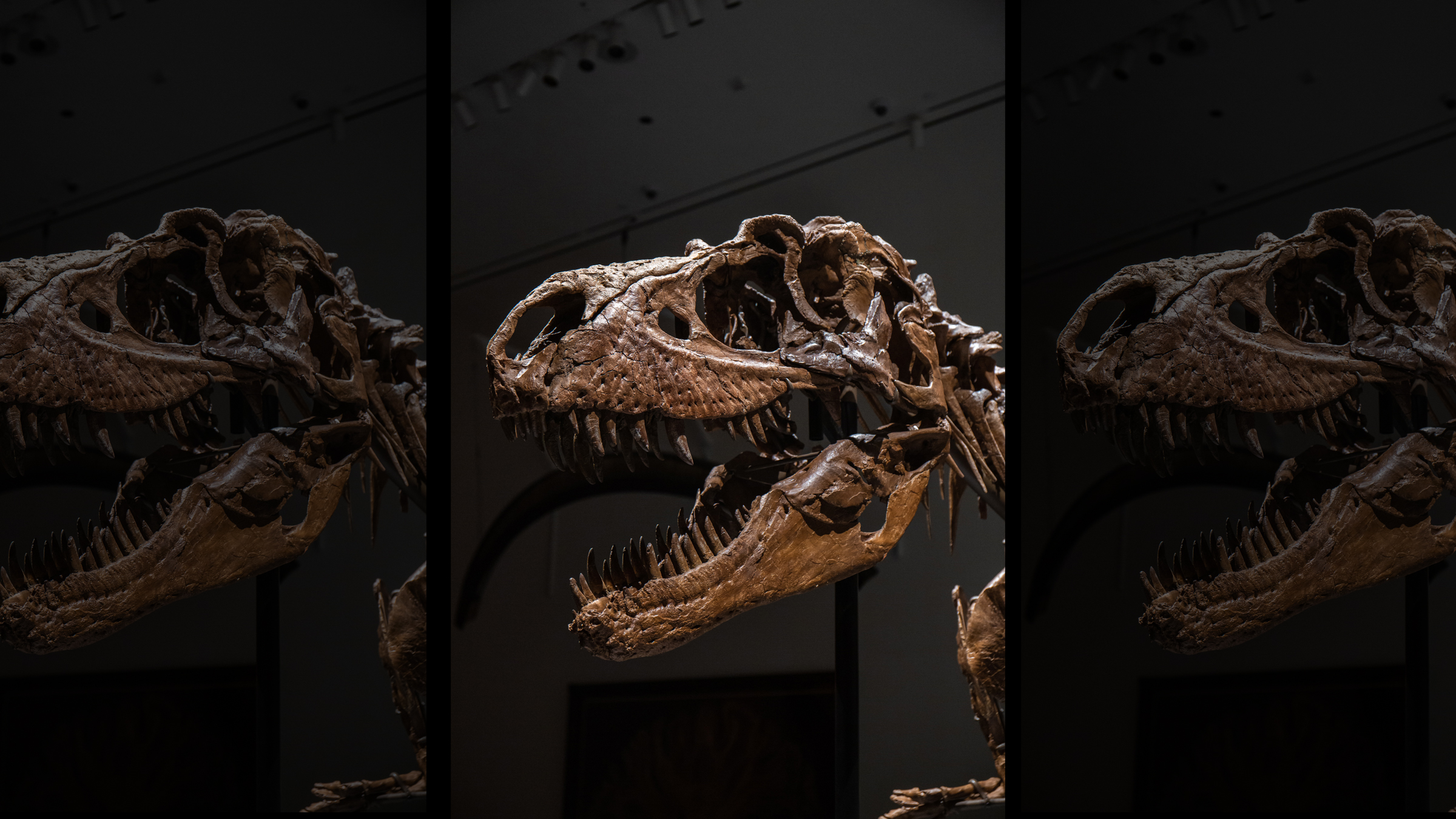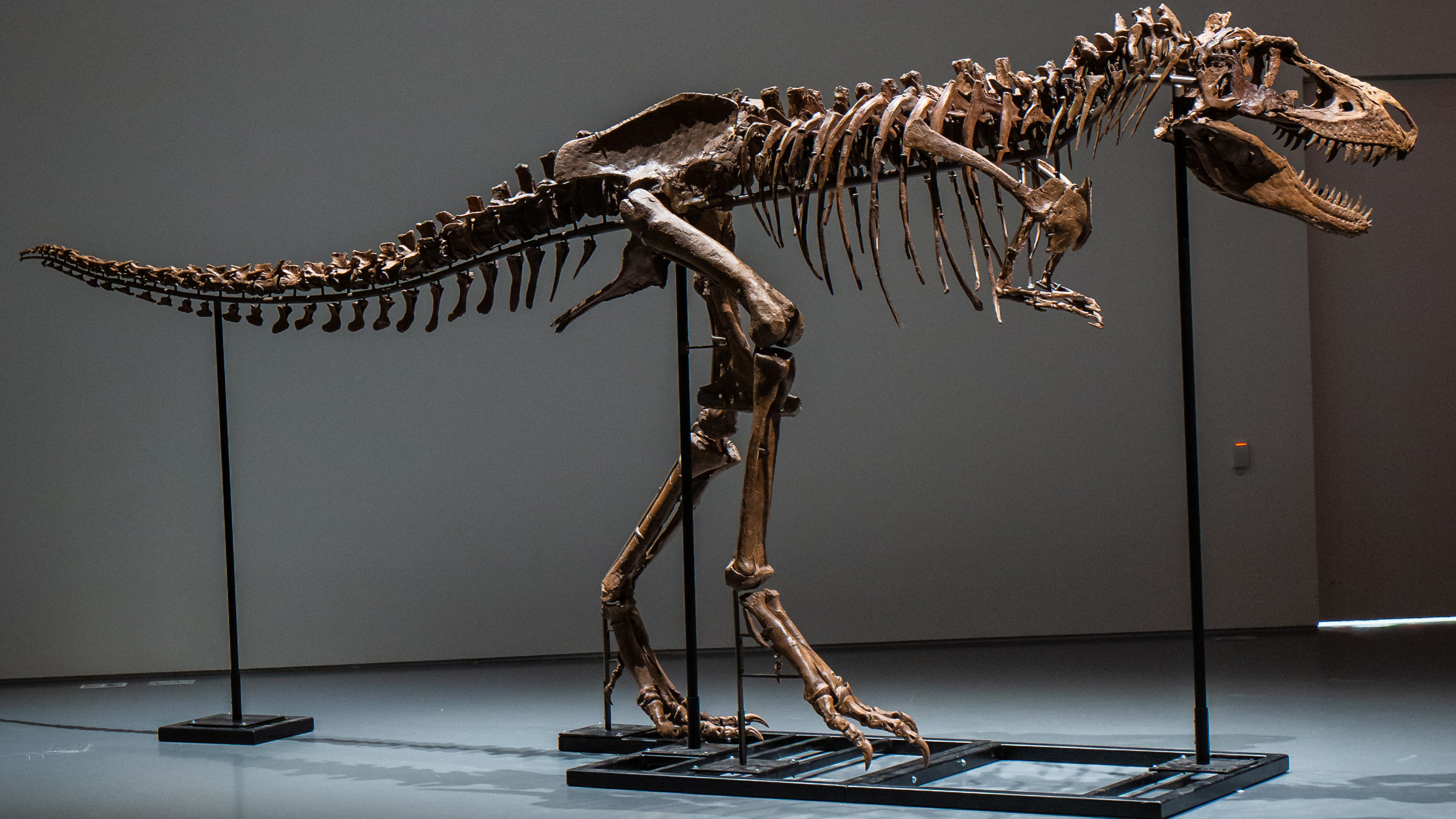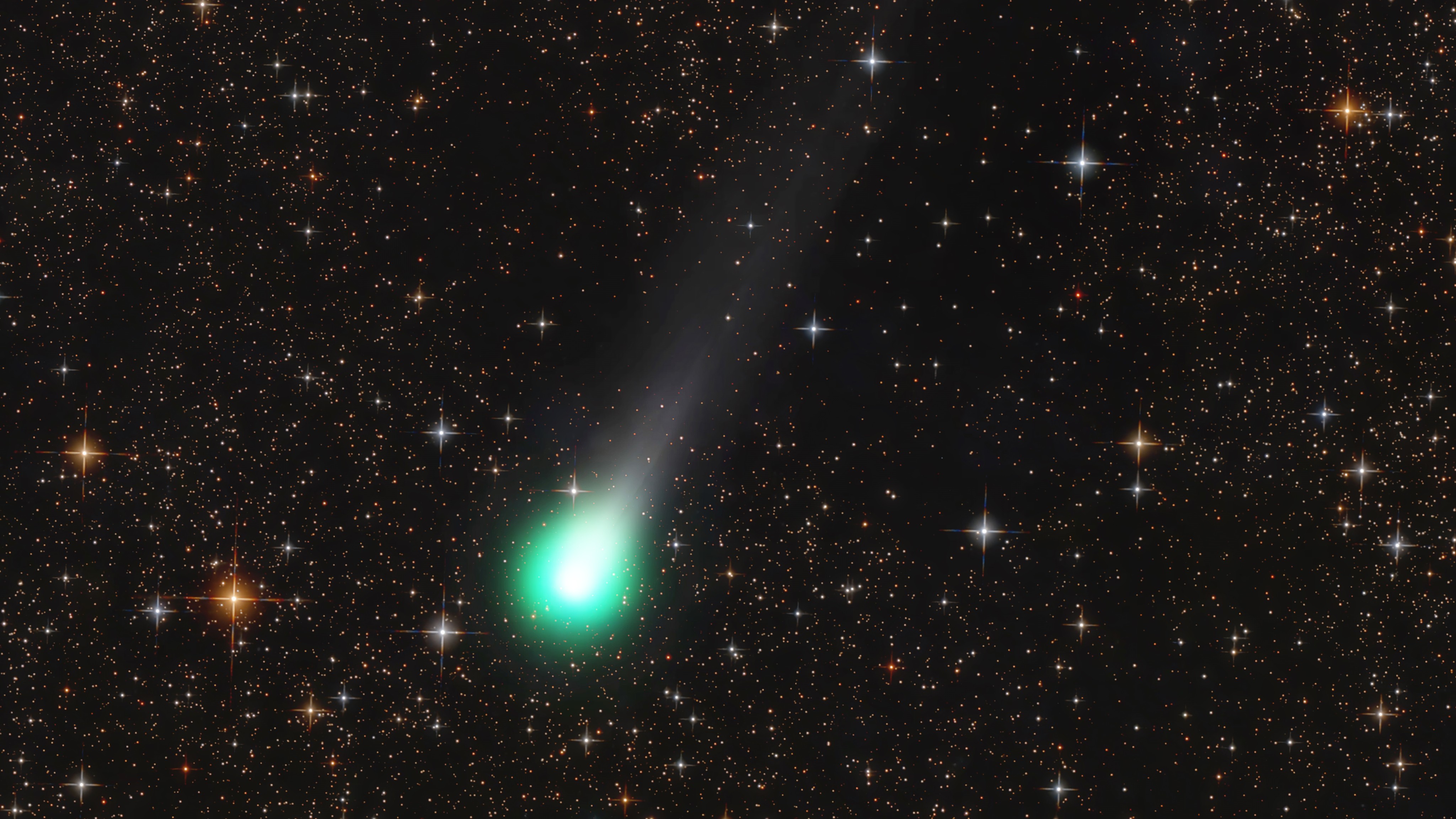First Gorgosaurus to hit auction block may sell for $8 million
This fierce dinosaur is a relative of T. rex.

The first specimen of the meat-eating dinosaur Gorgosaurus to ever hit the auction block will go before bidders in New York City on July 28, according to Sotheby's auction house.
Gorgosaurus, an apex predator, lived from 80 million to 73 million years ago, millions of years before its more famous relative, the formidable Tyrannosaurus rex, existed; it stalked its prey in parts of what is now the western United States and Canada, according to the Natural History Museum (NHM) in London. The beast's skeleton, measuring nearly 10 feet (3 meters) tall and 22 feet (6.7 m) long, or about the length of three king-size mattresses lined up head to foot, is expected to sell for at least $5 million and perhaps as much as $8 million, Sotheby's reported.
Plenty of dinosaur remains have hit the auction block before, including Deinonychus, the raptor that inspired the Velocirators' appearance in the "Jurassic Park" movies; a meat-eating Allosaurus; and Stan the T. rex, which sold for $31.8 million at auction in October 2020, making it the most expensive dinosaur fossil ever sold, Live Science previously reported. But this is the first Gorgosaurus to be auctioned, and while the auction is legal, scientists aren't too happy about it.
Related: Who will buy 'Big John,' the biggest triceratops ever found?
"Any time that a vertebrate fossil is being sold, potentially privately, it's disturbing," Gregory Erickson, a paleobiologist at Florida State University in Tallahassee who is not involved with the auction, told Live Science. "It steals away the potential for scientific advancement. But then again, in this case as near as I can tell, the specimen has been legally collected, so it's fair game. That's where our laws are."
Kat Schroeder, a paleomacroecologist at the University of New Mexico who is not involved with the auction, said it was "disappointing to see a good specimen of a rare dinosaur potentially on its way to a private collector." Often, specimens in private collections don't further paleontological research, "as they are either not made available to scientists, damaged during preparation, transport or storage, or essential information regarding the provenance is lost," she told Live Science in an email.
Gorgosaurus, Greek for "fierce lizard," was smaller than T. rex, but like its tyrannosaur relative, it had sharp serrated teeth and tiny arms. Adults could weigh up to 2 tons (1.8 metric tons), and the species had an acute sense of smell and hawk-like eyesight, according to Sotheby's.
Get the world’s most fascinating discoveries delivered straight to your inbox.
There are at least 12 complete or near-complete skulls and several partial skeletons of Gorgosaurus that are known to scientists, according to the NHM, making each specimen extremely valuable. To put that number into perspective, there are 58 T. rex specimens in public trusts, while 53 specimens are commercially or privately owned, meaning that scientists don't have guaranteed access to half of the known T. rex fossils, Thomas Carr, a vertebrate paleontologist and an associate professor of biology at Carthage College in Kenosha, Wisconsin, who is not involved with the Gorgosaurus sale, previously told Live Science.
Even 58 individuals is a small number for scientific study, Carr said, so the 12 known Gorgosaurus specimens are an especially limited group. Private owners of dinosaur fossils are under no obligation to share their specimens with scientists, and many paleontologists do not like studying fossils that aren't publicly available to the scientific community, as access to the specimen could be revoked at any time.
The soon-to-be-auctioned Gorgosaurus was unearthed in 2018 on private land at the Judith River Formation near Havre, Montana, an area famous for its dinosaur-era fossils.
"The discovery was particularly exceptional due to the rarity of Gorgosaurus material south of the Canadian border, this being one of only a tiny handful to be found in the United States," Sotheby's said in a statement.
The Canadian province of Alberta, where the first Gorgosaurus specimen was found in the early 1900s, has some of the strictest fossil protection laws in the world, according to the Royal Tyrrell Museum. The public cannot collect fossils that are buried, and even fossils that are found at the ground's surface belong to the Province of Alberta. In other words, a Gorgosaurus found in Alberta — just north of Montana — would not end up in an auction house.
Sotheby's declined to name the individuals or company that found the Cretaceous period (145 million to 66 million years ago) predator.
"We can’t comment on the identity of the consignors, but I can confirm that the skeleton is being consigned directly by the professionals who discovered and excavated it," Derek Parsons, a spokesperson at Sotheby's, told Live Science in an email.
Related: What's the Controversy Over the Baby T. Rex Listed on eBay?
Parsons added that the skeleton isn't complete, but "contains 79 unique elements, all from one individual Gorgosaurus, which is extremely rare as many skeletons are composed from multiple specimens."
The individual was mature when it died, and has a well-preserved skull that includes the left maxilla (upper jaw) and several cranial bones, such as three major orbit bones, according to Sotheby's. The specimen also has neck, back and tail vertebrae and a well-preserved pelvis.
In photos, this Gorgosaurus specimen "looks spectacular," Erickson noted. When he started working as a paleontologist in the 1980s, U.S. landowners often let scientists search for fossils on their property free of charge, as dinosaur bones weren't viewed as having much value back then, he said. But in the decades that followed, the popularity of the "Jurassic Park" movies, the rise of eBay and news of celebrities buying dinosaur fossils as art has raised the price of dinosaur remains. "All of a sudden dinosaurs went from being financially worth nothing to being worth a lot of money," Erickson said.
In the best case scenario, a museum would buy this Gorgosaurus, he said. However, museums often struggle to pay high price tags seen at auctions, Erickson added. Another way forward, although not for this specimen, is for paleontologists to make connections with private excavators, who may donate or sell specimens at a reduced rate to scientists, he said.
"We shall have to hope that if this specimen is as nice as it seems, that whomever ends up with it will be willing to donate it to a museum," Schroeder said.
The public can see the Gorgosaurus starting on July 21 at Sotheby's York Avenue galleries in New York City.
Editor's note: Updated at 12:02 p.m. EDT to update Kat Schroeder's title to paleomacroecologist at the University of New Mexico.
Originally published on Live Science.

Laura is the archaeology and Life's Little Mysteries editor at Live Science. She also reports on general science, including paleontology. Her work has appeared in The New York Times, Scholastic, Popular Science and Spectrum, a site on autism research. She has won multiple awards from the Society of Professional Journalists and the Washington Newspaper Publishers Association for her reporting at a weekly newspaper near Seattle. Laura holds a bachelor's degree in English literature and psychology from Washington University in St. Louis and a master's degree in science writing from NYU.


